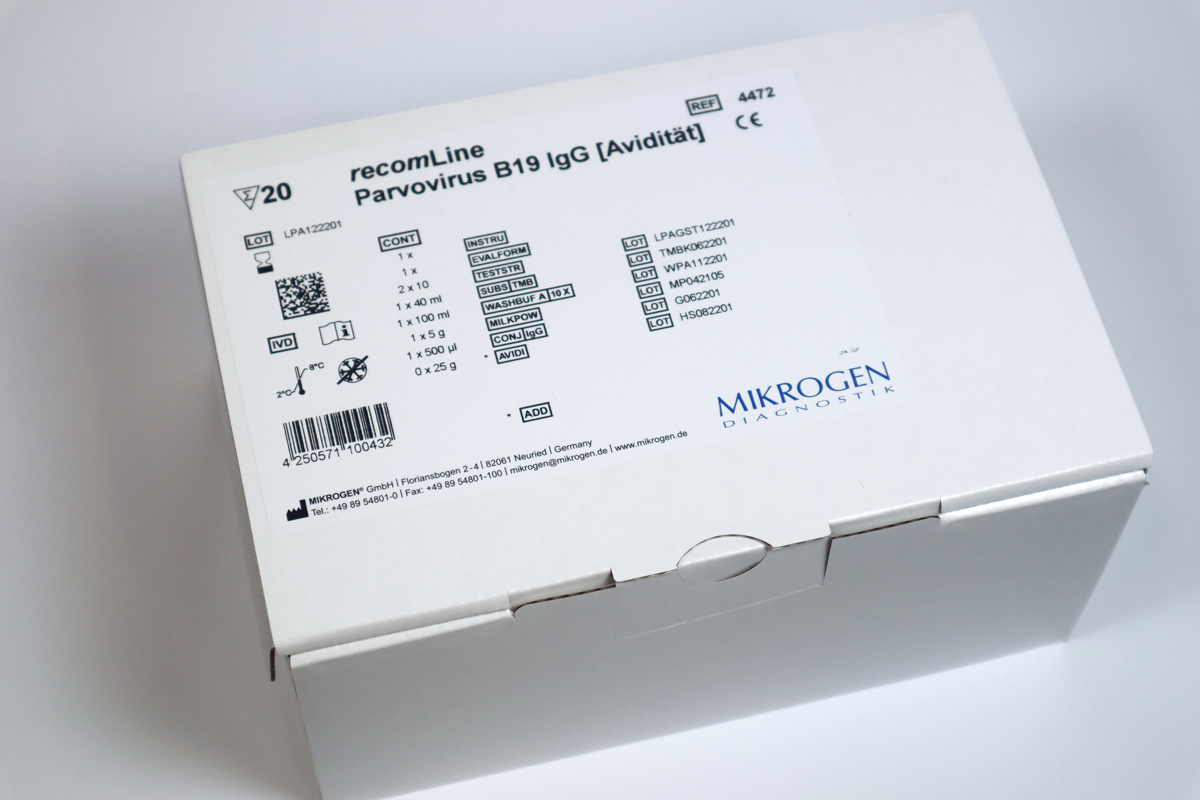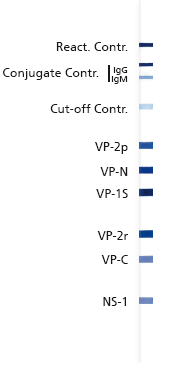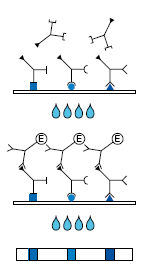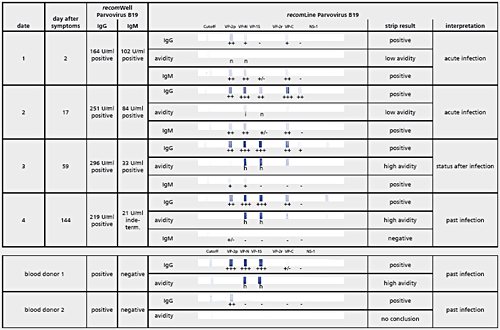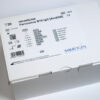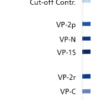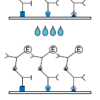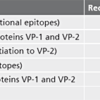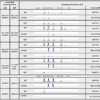Mikrogen Diagnostik recomLine Parvovirus B19 IgG (Avidity) Lateral Strip Test Kit (4472)
$550.00
| Host | Quantity | Applications | Species Reactivity | Data Sheet | |
|---|---|---|---|---|---|
| 20 Tests | Lateral Strip Assay | Parvovirus B19 |  |
SKU: 4472
Categories: Infectious Disease Test Kits and Positive Controls, MIKROGEN Products
Overview
Product Name Mikrogen Diagnostik recomLine Parvovirus B19 IgG (Avidity) Lateral Strip Test Kit (4472)
Description Strip-Immunoassay with antigens produced by recombinant techniques for the detection of IgG and IgM antibodies against human Parvovirus B19
Product is intended for research use.
Product is intended for research use.
Target Human Parvovirus B19 IgG
Species Reactivity Parvovirus B19
Assay Type Indirect Sandwich ELISA
Applications Lateral Strip Assay
Associated Products recomWell Parvovirus B19 IgG/IgM ELISA Kit (4404)
recomWell Parvovirus B19 IgM ELISA Kit (4404)
recomLine Parvovirus B19 IgM Lateral Strip Test Kit (4473)
Parvovirus B19 IgG Control Serum (C122G)
Parvovirus B19 IgM Control Serum (C122M)
Parvovirus IgG ELISA Kit (ESR122G)
Parvovirus IgM ELISA Kit (ESR122M)
Parvovirus B19 VP1 Antigen (BA122VSVP1)
Parvovirus B19 VLP Antigen (BA122VSVP2)
Parvovirus B19 PepB (VP2 C-term) Antigen (BA122VSVP1B)
Parvovirus B19 NS1 Antigen (BA122VSNS1)
Parvovirus B19 PepA (VP1 unique) Antigen (BA122VSVP1A)
Parvovirus B19 PepC (VP1 N-term) Antigen (BA122VSVP1C)
Parvovirus B19 PepD (VP1 C-term) Antigen (BA122VSVP1D)
Parvovirus B19 VP2 Antigen (BA122VSVP1E)
recomWell Parvovirus B19 IgM ELISA Kit (4404)
recomLine Parvovirus B19 IgM Lateral Strip Test Kit (4473)
Parvovirus B19 IgG Control Serum (C122G)
Parvovirus B19 IgM Control Serum (C122M)
Parvovirus IgG ELISA Kit (ESR122G)
Parvovirus IgM ELISA Kit (ESR122M)
Parvovirus B19 VP1 Antigen (BA122VSVP1)
Parvovirus B19 VLP Antigen (BA122VSVP2)
Parvovirus B19 PepB (VP2 C-term) Antigen (BA122VSVP1B)
Parvovirus B19 NS1 Antigen (BA122VSNS1)
Parvovirus B19 PepA (VP1 unique) Antigen (BA122VSVP1A)
Parvovirus B19 PepC (VP1 N-term) Antigen (BA122VSVP1C)
Parvovirus B19 PepD (VP1 C-term) Antigen (BA122VSVP1D)
Parvovirus B19 VP2 Antigen (BA122VSVP1E)
Properties
Background Human Parvovirus B19 occurs endemically world-wide. At intervals of several years, it causes epidemics in small areas from late fall to early summer, affecting kindergartens and schools in particular.Its surface is formed by a protein envelope which consists of two polypeptides (VP-1 and VP-2). VP-1 differs from VP-2 only by an additional N-terminal fragment. Furthermore, a non-structural protein (NS-1) is synthesized, which is required for virus replication.Clinical spectrum of a Parvovirus B19 infection:Fifth disease (erythema infectiosum): It progresses in 20% of cases without symptoms or with flu-like symptoms. Apart from the exanthema, polyarthralgia and a generalized swelling of the lymph nodes can occur occasionally.Aplastic crisis in patients suffering from hemolytic anemias.Spontaneous abortion/hydrops fetalis after infection during pregnancy.Persistent infection in immunosuppressed persons with chronic anemia and bone marrow depression.By the kind of antigen pattern and the avidity determination of IgG antibodies the recomLine Parvovirus B19 provides an indication of the time of infection. The determination of antibodies against the NS-1 antigen can be helpful in the clarification of persistent Parvovirus B19 infections. With the use of VP-2 particles the presentation of conformational epitopes in addition to the linear epitopes is achieved.
Sample Type Serum, plasma, whole blood
Assay Resolution See Figure
Components
| 10X Wash Buffer | 100 mL |
| TMB Substrate | 40 mL |
| Milk Powder | 5 g |
| Instuctions for Use | 1 Each |
| Evaluation Form | 1 Each |
| Test Strips | 2 Vials x 10 Each |
| Anti-Human IgG Conjugate | 500 uL |
Specificity Information
Target ID Human Parvovirus B19 IgG
Research Areas Infectious Disease
Application Images







Description Strip Layout

Description Test Principle and Procedure:
1. 1st Incubation. A test strip loaded with Parvovirus B19 antigens is incubated with diluted serum or plasma in a dish for
1 hour.
2. Wash 3 times
3. 2nd Incubation
4. Peroxidase conjugated anti-human antibodies (IgG or IgM specific) are added. Incubate for 45 minutes.
5. Wash 3 times
6. Color reaction
7. 8 minutes after addition of the coloring solution, insoluble colored bands develop at the sites on the test strips occupied by antibodies.
1. 1st Incubation. A test strip loaded with Parvovirus B19 antigens is incubated with diluted serum or plasma in a dish for
1 hour.
2. Wash 3 times
3. 2nd Incubation
4. Peroxidase conjugated anti-human antibodies (IgG or IgM specific) are added. Incubate for 45 minutes.
5. Wash 3 times
6. Color reaction
7. 8 minutes after addition of the coloring solution, insoluble colored bands develop at the sites on the test strips occupied by antibodies.

Description Related recombinant Parvovirus B19 antigens

Description Example sample data.
Typical Parvovirus B19 course of infection and two examples of healthy blood donors with past infections. The course of infection covers a period of approx. 21 weeks after appearance of symptoms. IgM reactivity decreased significantly between sample 2 and 3. The decrease of the VP-C IgG reactivity, the high avidity and the appearance of NS-1 IgG antibodies indicate a status after infection (sample 3). High avidity appears earliest 4 weeks after infection. NS-1 antibodies titers appear only six to eight weeks after infection, but not in all patients. In a study samples from blood donors were tested, 66% were IgG positive. Many samples presented this typical antigens pattern in past infections as shown. In Germany the infection rate in adults is about 60% and in children between 15-30%.
Typical Parvovirus B19 course of infection and two examples of healthy blood donors with past infections. The course of infection covers a period of approx. 21 weeks after appearance of symptoms. IgM reactivity decreased significantly between sample 2 and 3. The decrease of the VP-C IgG reactivity, the high avidity and the appearance of NS-1 IgG antibodies indicate a status after infection (sample 3). High avidity appears earliest 4 weeks after infection. NS-1 antibodies titers appear only six to eight weeks after infection, but not in all patients. In a study samples from blood donors were tested, 66% were IgG positive. Many samples presented this typical antigens pattern in past infections as shown. In Germany the infection rate in adults is about 60% and in children between 15-30%.
Additional Information
Additional Information Additional Mirkogen Kit Information
Handling
Storage Store at 2-8°C.
References & Data Sheet
Data Sheet  Download PDF Data Sheet
Download PDF Data Sheet
 Download PDF Data Sheet
Download PDF Data Sheet

